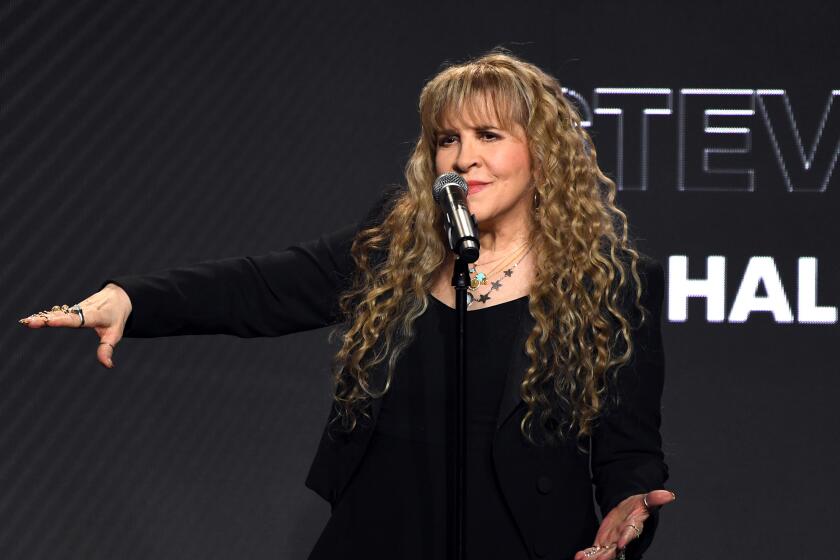POP MUSIC REVIEW : Paladins Hold Fort for Clay : The San Diego roots rockers shine at Bogart’s in the absence of their soul-singing co-headliner.
- Share via
LONG BEACH — One couldn’t help but be disappointed to arrive at Bogart’s Thursday evening and find that soul singer Otis Clay had canceled his co-headlining show with the Paladins. Clay had to be a bit disappointed himself, considering he and his broken-down bus had spent Christmas in rainy Tennessee.
Clay is one of the last of the ‘60s soul singers, from the highly emotive gospel-based school that graduated Otis Redding, Wilson Pickett and other greats. Clay is expected to be in town by tonight to share the bill with the Paladins at the Palomino in North Hollywood.
That’s a show doubly worth seeing because, however much one might have been let down heading into Bogart’s, one left exhilarated having witnessed what a tremendous a band the Paladins has become. During the last few years the San Diego-based trio has become one of the most powerful roots-rocking groups in the nation.
Despite a recent change behind the drum set--the new stickman is Michael Cherry--the group sounds as tight as if it had been playing together a lifetime, yet with an enthusiasm that’s fresh out of the garage.
When the trio formed in the mid-’80s, it was heavily influenced by Orange County’s James Harman Band; clearly it also has been touched by tours with the late Stevie Ray Vaughan and the Fabulous Thunderbirds. While those influences, particularly Vaughan’s, still figure in the guitar playing, singing and writing of front man Dave Gonzales, he’s fused them into his own style.
The clearest assertion of his individual stamp was heard on Willie Dixon’s “Close to You,” a song also assayed by Vaughan on his posthumous “The Sky is Crying” album. While Vaughan took the tune as a straight-ahead Texas shuffle, Gonzales built a mildly ominous descending riff into it, adding an obsessive dimension.
Those defining flourishes set the group apart from most of the roots-rock milieu. Like the Austin, Tex.-based Tailgators, the Paladins are a groove-monster party band, plunging directly from one song into the next without drawing a breath. But without losing that dance-hall drive, they also work in rich melodies and complex chord structures.
Much of the set was drawn from 1990’s “Let’s Buzz” album, including the stomping title track that opened the show. Veering from the blues and rockabilly that previously were the group’s staples, “I Don’t Believe” was a funk-based ninth-chord workout, spiced with some Hendrix-like motion on Gonzales’ low strings. The churning “What Side of the Door Am I On?” and “Years Since Yesterday” both showed a strong Vaughan influence. Gonzales’ excursions on his ‘50s Guild arch-top guitar were scarcely less impassioned than the late master’s. Gonzales’ vocals--sometimes merely well-intentioned in years past--are now nearly as fierce as his guitar work.
Upright bassist Tom Yearsley took the lead vocals on “Good Lovin’ ” and two other tunes, and strutted his slap-happy bass style in a solo on “I Had a Dream Last Night.” Before the encore call, which included an uproarious rendition of “You Can’t Judge a Book by Looking at the Cover,” the trio closed with its standard centerpieces, the long, sinuous blues “Lover’s Rock” and the grinding “Hold On,” on which Gonzales’ guitar had the sort of bite you could chew beer bottles open with.
East L.A.’s Blazers--a last-minute addition when Clay canceled--also keep their roots rock well nourished. The quartet shows a strong Los Lobos influence, particularly in the twin-guitar arrangements of Manuel Gonsales and Ruben Guaderrama, and in Gonsales’ rich David Hidalgo-like vocals. It comes as no great surprise that Lobos’ Cesar Rosas produced the group’s debut EP
Though the Blazers’ material started seeming a mite thin by the end of the 75-minute set, most of the performance was hard-driving blues rock, tempered with a keen musical intelligence. Both Gonsales and Guaderrama are fine guitarists, who were at their best mixing blues licks with a Latin melodicism on the band’s Spanish-language songs “Ano Viejo,” “De un Rancho a Otro” and “Tiburon Tiburon.”
More to Read
The biggest entertainment stories
Get our big stories about Hollywood, film, television, music, arts, culture and more right in your inbox as soon as they publish.
You may occasionally receive promotional content from the Los Angeles Times.









